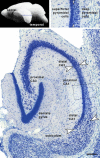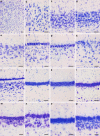Hippocampal pyramidal cells: the reemergence of cortical lamination
- PMID: 21597968
- PMCID: PMC3197924
- DOI: 10.1007/s00429-011-0322-0
Hippocampal pyramidal cells: the reemergence of cortical lamination
Abstract
The increasing resolution of tract-tracing studies has led to the definition of segments along the transverse axis of the hippocampal pyramidal cell layer, which may represent functionally defined elements. This review will summarize evidence for a morphological and functional differentiation of pyramidal cells along the radial (deep to superficial) axis of the cell layer. In many species, deep and superficial sublayers can be identified histologically throughout large parts of the septotemporal extent of the hippocampus. Neurons in these sublayers are generated during different periods of development. During development, deep and superficial cells express genes (Sox5, SatB2) that also specify the phenotypes of superficial and deep cells in the neocortex. Deep and superficial cells differ neurochemically (e.g. calbindin and zinc) and in their adult gene expression patterns. These markers also distinguish sublayers in the septal hippocampus, where they are not readily apparent histologically in rat or mouse. Deep and superficial pyramidal cells differ in septal, striatal, and neocortical efferent connections. Distributions of deep and superficial pyramidal cell dendrites and studies in reeler or sparsely GFP-expressing mice indicate that this also applies to afferent pathways. Histological, neurochemical, and connective differences between deep and superficial neurons may correlate with (patho-) physiological phenomena specific to pyramidal cells at different radial locations. We feel that an appreciation of radial subdivisions in the pyramidal cell layer reminiscent of lamination in other cortical areas may be critical in the interpretation of studies of hippocampal anatomy and function.
© The Author(s) 2011. This article is published with open access at Springerlink.com
Figures






Similar articles
-
Q- and L-type calcium channels control the development of calbindin phenotype in hippocampal pyramidal neurons in vitro.Eur J Neurosci. 2000 Jun;12(6):2068-78. doi: 10.1046/j.1460-9568.2000.00105.x. Eur J Neurosci. 2000. PMID: 10886346
-
Pyramidal cell dendrites are the primary targets of calbindin D28k-immunoreactive interneurons in the hippocampus.Hippocampus. 1996;6(5):525-34. doi: 10.1002/(SICI)1098-1063(1996)6:5<525::AID-HIPO5>3.0.CO;2-H. Hippocampus. 1996. PMID: 8953305
-
Internal structure of the rat subiculum characterized by diverse immunoreactivities and septotemporal differences.Neurosci Res. 2020 Jan;150:17-28. doi: 10.1016/j.neures.2019.02.001. Epub 2019 Feb 13. Neurosci Res. 2020. PMID: 30768950
-
Cellular distribution of the calcium-binding proteins parvalbumin, calbindin, and calretinin in the neocortex of mammals: phylogenetic and developmental patterns.J Chem Neuroanat. 1999 Feb;16(2):77-116. doi: 10.1016/s0891-0618(98)00065-9. J Chem Neuroanat. 1999. PMID: 10223310 Review.
-
Pyramidal neurons: dendritic structure and synaptic integration.Nat Rev Neurosci. 2008 Mar;9(3):206-21. doi: 10.1038/nrn2286. Nat Rev Neurosci. 2008. PMID: 18270515 Review.
Cited by
-
Juxtacellular opto-tagging of hippocampal CA1 neurons in freely moving mice.Elife. 2022 Jan 26;11:e71720. doi: 10.7554/eLife.71720. Elife. 2022. PMID: 35080491 Free PMC article.
-
The Corticohippocampal Circuit, Synaptic Plasticity, and Memory.Cold Spring Harb Perspect Biol. 2015 Nov 2;7(11):a021733. doi: 10.1101/cshperspect.a021733. Cold Spring Harb Perspect Biol. 2015. PMID: 26525152 Free PMC article. Review.
-
Taxonomic Separation of Hippocampal Networks: Principal Cell Populations and Adult Neurogenesis.Front Neuroanat. 2016 Mar 9;10:22. doi: 10.3389/fnana.2016.00022. eCollection 2016. Front Neuroanat. 2016. PMID: 27013984 Free PMC article.
-
Medial and Lateral Entorhinal Cortex Differentially Excite Deep versus Superficial CA1 Pyramidal Neurons.Cell Rep. 2017 Jan 3;18(1):148-160. doi: 10.1016/j.celrep.2016.12.012. Cell Rep. 2017. PMID: 28052245 Free PMC article.
-
Segregated Cell Populations Enable Distinct Parallel Encoding within the Radial Axis of the CA1 Pyramidal Layer.Exp Neurobiol. 2017 Feb;26(1):1-10. doi: 10.5607/en.2017.26.1.1. Epub 2017 Feb 13. Exp Neurobiol. 2017. PMID: 28243162 Free PMC article. Review.
References
-
- Abbie AA. The relations of the fascia dentata, hippocampus and neocortex, and the nature of the subiculum. J Comp Neurol. 1938;68:307–333. doi: 10.1002/cne.900680303. - DOI
Publication types
MeSH terms
Substances
LinkOut - more resources
Full Text Sources

